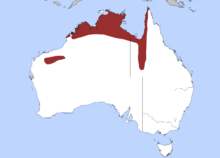Liasis olivaceus
| Olive python | |
|---|---|
.jpg) | |
| Scientific classification | |
| Kingdom: | Animalia |
| Phylum: | Chordata |
| Subphylum: | Vertebrata |
| Class: | Reptilia |
| Order: | Squamata |
| Suborder: | Serpentes |
| Family: | Pythonidae |
| Genus: | Liasis |
| Species: | L. olivaceus |
| Binomial name | |
| Liasis olivaceus Gray, 1842 | |
 | |
| Distribution of the olive python | |
| Synonyms | |
| |
Liasis olivaceus, commonly called the olive python,[2] is a python species found in Australia. Two subspecies are currently recognized, including the nominate subspecies described here.[3]
Description
With adults reaching over 4 m in length, this is Australia's second-largest snake species (surpassed only by the scrub python). Its high midbody dorsal scale count, 61-72, makes the skin look smoother than that of other pythons. The number of ventral scales is 355-377.[2] The colour pattern is a uniform chocolate brown to olive green, while the belly is usually cream coloured.[4]
Unfortunately, this species is occasionally confused with the venomous king brown snake, Pseudechis australis, and killed as a consequence.[2]
Geographic range
This snake is found in Australia in Western Australia, Northern Territory and Queensland. The type locality given is "North Australia; Port Essington" (Northern Territory, Australia).[1]
Habitat
It occurs in rocky areas, gorges and especially rocky areas near sources of water. Typically, shelter is sought in caves and rock crevices, but individuals have also been found in hollow logs and in burrows under rocks.[2]
Feeding
The diet consists of birds, mammals and other reptiles,[2] including rock-wallabies, fruit bats, ducks and spinifex pigeons. They prefer to lie in wait next to animal trails to ambush their prey. Alternatively, they are strong swimmers and also hunt in waterholes, striking at prey from under the water.[4] They are also known to prey on monitor lizards and crocodiles.[5]
Reproduction
Mating activity starts in May and continue through until mid-July. When successful, this is followed by a gestation period of 81–85 days, after which the oviparous females lay 12-40 eggs in late spring.[4] The average clutch size is around 19 eggs.[2] The hatchlings emerge after an incubation period of about 50 days, each measuring about 35 cm in length.[4]
Subspecies
| Subspecies[3] | Taxon author[3] | Common name[2] | Geographic range[6] |
|---|---|---|---|
| L. o. barroni | Smith, 1981 | Pilbara olive python | Australia in the Pilbara region of Western Australia |
| L. o. olivaceus | Gray, 1842 | Olive python | Australia from the Kimberley region in Western Australia to the area around Mount Isa in Queensland |
Images

See also
- List of pythonid species and subspecies
- Pythonidae by common name
- Pythonidae by taxonomic synonyms
References
- 1 2 McDiarmid RW, Campbell JA, Touré T. 1999. Snake Species of the World: A Taxonomic and Geographic Reference, vol. 1. Herpetologists' League. 511 pp. ISBN 1-893777-00-6 (series). ISBN 1-893777-01-4 (volume).
- 1 2 3 4 5 6 7 Olive python, Liasis olivaceus at Pilbara Pythons. Accessed 4 August 2008.
- 1 2 3 "Liasis olivaceus". Integrated Taxonomic Information System. Retrieved 4 August 2008.
- 1 2 3 4 Olive Python at Currumbin Wildlife Sanctuary. Accessed 4 August 2008. Archived 24 October 2007 at the Wayback Machine.
- ↑ http://www.abc.net.au/local/photos/2014/03/03/3955563.htm
- ↑ Captive maintenance and breeding of olive python at Victorian Herpetological Society. Accessed 4 August 2008.
External links
- video of a wild Olive Python in Kakadu National Park, NT
- Liasis olivaceus at the Reptarium.cz Reptile Database. Accessed 4 August 2008.
- Photo of wild Olive Python attempting to eat wallaby